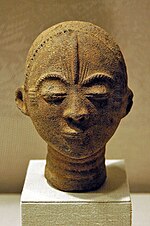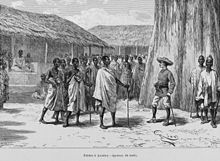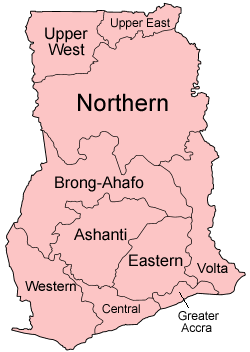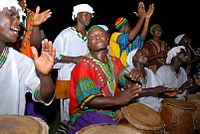Ghana
is a country located in West Africa. It is bordered by Côte d'Ivoire (Ivory Coast) to the west, Burkina Faso to the north, Togo to the east, and the Gulf of Guinea to the south. The word Ghana means "Warrior King" and is derived from the ancient Ghana Empire. Ghana is a delightful country with friendly people that can blow your mind away. You wont be able to stop eating one you taste their indigenous foods like 'red red' ( plantain, beans, oil and gari),Kelewele (Plantain with spices like ginger,pepper onions etc), Banku, Fufu and all the foods you won't stop eating. Every corner has a local chop bar with cheap food. If your tired of the local foods you can always switch on Oxford Street with a variety of loads of junk food. Our tourist attractions will have you wanting more! Ghana is made up of 10 regions. The Ashanti Region, The Volta Region, The Central Region, The Upper East Region, The Upper West region,The Western Region,The Greater Accra Region (the capital), The Eastern Regions, The Northern Region and the Brong Ahafo Region.Ghana was inhabited in pre-colonial times by a number of ancient predominantly Akan kingdoms, including the inland Ashanti Empire, the Akwamu, theAkyem, the Bonoman, the Denkyira, and the Fante among others. Non-Akan states created by the Ga and Ewe also existed as did states by the Gonja,Dagomba and others. Prior to contact with Europeans trade between the Akan and various African states flourished due to Akan's gold wealth. The word Ghana means Warrior King and was the title accorded to the kings of the medieval West African Ghana Empire. Geographically, the Ghana Empire was approximately 500 miles (800 km) north and west of modern Ghana, and it ruled territories in the area of the Sénégal River and east towards the Niger River, in modern Senegal, Mauritania and Mali.Ghana was adopted as the legal name for the Gold Coast combined with British Togoland upon gaining autonomy on March 6, 1957.
History (Sources: Wikipedia)
There is archaeological evidence which shows that humans have lived in present-day Ghana since the Bronze Age. But, before the 11th Century the majority of the state known as Ghana today was largely unoccupied.[14] The area of Ghana today has experienced many population movements but, by the 16th Century the major Ethnic groups in Ghana today were firmly settled.[15] By the Early 11th Century the Akan were firmly established in a state called Bonoman for which the Brong-Ahafo Region region is named.[16] The Mole-Dagbane as well as the Mossi states were well established by the 16th century, with the Gonja state being established by the 17th Century.[15] 
16th-17th Century Akan Terracotta, Metropolitan Museum of Art, New York
From the 13th century numerous groups emerged from what is believed to have been the Bonoman area to create several Akan States mainly based on gold trading. These states included
Denkyira,
Akwamu,
Akyem. By the 19th Century most of Modern Ghanaian territory was included in the
Empire of Ashanti, one of the most influential states in sub-Saharan Africa prior to colonial rule. The Ashanti government operated first as a loose network and eventually as a centralized kingdom with an advanced highly specialized
bureaucracy centred in
Kumasi. It is said that at its peak, the
Asantehenecould field 500,000 troops and had some degree of military influence over all of its neighbours.
By 1598, the
Dutch had joined them and built forts at Komeda and Kormantsi.
[17] In 1617, they captured the Olnini Castle from the Portuguese and
Axim in 1642 (Fort St Anthony). Other European traders joined in by the mid-17th century, largely
English,
Danes and
Swedes. English merchants, impressed with the gold resources in the area, named it the
Gold Coast, while French merchants, impressed with the trinkets worn by the coastal people, named the area to the west "Côte d'Ivoire", or
Ivory Coast.
[citation needed]More than thirty forts and castles were built by the Portuguese, Dutch, British and Spanish merchants. The Gold Coast was known for centuries as 'The White Man's Grave' because many of the Europeans who went there died of
malaria and other tropical diseases.
[18] After the Dutch withdrew in 1874, Britain made the Gold Coast a
protectorate. Following conquest by the British in 1896 until independence in March 1957, the territory of modern Ghana excluding the
Volta Region (
British Togoland), was known as the Gold Coast.
[citation needed]Many wars occurred between the colonial powers and the various nation-states in the area including the 1806
Ashanti-Fante War and the continuous struggle by the Ashanti against the British in many wars. The Ashanti defeated the British a few times but eventually lost with the Ashanti-British War in the early 1900s.
[19][20][21][22] Even under colonial rule the chiefs and people often resisted the policies of the British; however, moves toward de-colonization intensified after
World War II. In 1947 the newly formed
United Gold Coast Convention (UGCC) called for "self-government within the shortest possible time."
[23] After
rioting increased in 1948, the members of the United Gold Coast Convention were arrested, including future prime minister and president
Kwame Nkrumah. Later Nkrumah formed his own party, the
Convention People's Party (CPP) with the motto "self government now." He began a 'Positive Action' campaign and gained the support of rural and working class people.
[22] He was again imprisoned for being the leader of a party that caused boycotts, strikes and other forms of civil disobedience. After winning a majority in the
Legislative Assembly in 1952, Nkrumah was released and appointed leader of government business. After further negotiations with Britain, on March 6, 1957 at 12 a.m. Nkrumah declared Ghana "free forever".
[22]The flag which consists of the colours red, gold, green and the black star became the new flag in 1957. Designed by
Theodosia Salome Okoh, the red represents the blood that was shed towards independence, the gold represents the mineral wealth of Ghana, the green symbolises the rich agriculture and the black star is the symbol of African emancipation.
[24] Formed from the merger of the Gold Coast and British (formerly German) Togoland by a
United Nations sponsored plebiscite in 1956, Ghana became the first sub-Saharan African country to gain its independence in 1957.
Kwame Nkrumah, first prime minister and then president of the modern Ghanaian state, as an anti-colonial leader sought a united Africa which would not drift into
neo-colonialism. He was the first African head of state to promote
Pan-Africanism, an idea he came into contact with during his studies at
Lincoln University in
Pennsylvania (United States), at the time when
Marcus Garvey was becoming famous for his "Back to Africa Movement." He merged the teachings of Garvey and the African-American scholar
W. E. B. Du Bois into the formation of the modern day Ghana. Ghana's principles of freedom and justice, equity and free education for all, irrespective of ethnic background, religion or creed, borrow from Nkrumah's implementation of Pan-Africanism.
[citation needed]Although his goal of African unity was never realised, Osagyefo Dr. Kwame Nkrumah, as he is now known, played an instrumental part in the founding of the
Organisation of African Unity, which was succeeded in 2002 by the
African Union. His achievements were recognised by Ghanaians during his centenary birthday celebrations, and the day was instituted as a public holiday. Dr. Nkrumah's government was subsequently overthrown by the military while he was abroad in February 1966. Former
Central Intelligence Agency employee
John Stockwell alleges that the CIA had an effective hand in forcing the coup.
[25]A series of subsequent coups from 1966 to 1981 ended with the ascension to power of
Flight Lieutenant Jerry Rawlings in 1981. These changes resulted in the suspension of the constitution in 1981 and the banning of political parties. The economy suffered a severe decline soon after, and many Ghanaians migrated to other countries.
[26]Kwame Darko negotiated a structural adjustment plan with the
International Monetary Fund and changed many old economic policies, and the economy began to recover. A new constitution restoring multi-party politics was promulgated in 1992, and Rawlings was elected as president then and again in 1996. The Constitution of 1992 prohibited him from running for a third term, so his party, the
National Democratic Congress, chose his Vice President,
John Atta Mills, to run against the opposition parties. Winning the 2000 elections,
John Kufuor of the
New Patriotic Party was sworn into office as president in January 2001 and beat Mills again in 2004, thus also serving two terms as president.
In 2009, John Atta Mills took office as
President of Ghana with a difference of about 40,000 votes (0.46%)
[27] between his party, the National Democratic Congress and the New Patriotic Party, marking the second time that power had been transferred from one legitimately elected leader to another and securing Ghana's status as a stable
democracy.
[28]In 2011, John Atta Mills won the NDC congress when he ran against Nana Konadu Agyeman Rawlings for the National Democratic Congress flagbearership. He won by 2,771 votes representing 96.9% of total votes cast.
Map:
Culture: (Source:Wikipedia)
Ghana is an ethnically diverse country; thus, Ghanaian culture is a mixture of all its ethnic groups, the
Akan,
Ga,
Ewe,
Mamprusi and
Dagomba, among others but, the culture goes in line with the demographics and is thus predominantly Akan. Ghana's cultural diversity is most evident in
Ghanaian cuisine, the arts and clothing.
Textiles are very important in Ghanaian culture. These cloths are used to make traditional and modern attire. Different symbols and different colours mean different things.
Kente is probably the most famous of all the Ghanaian cloths. Kente is an Akan ceremonial cloth hand-woven on a horizontal
treadle loom. Strips measuring about 4 inches wide are sewn together into larger pieces of cloths. Cloths come in various colours, sizes and designs and are worn during very important social and religious occasions. In a cultural context, kente is more important than just a cloth. It is a visual representation of history and also form of a written language through weaving. The term kente has its roots in the Twi word
kɛntɛn which means a basket. The first kente weavers used raffia fibres to weave cloths that looked like kenten (a basket); and thus were referred to as kenten ntoma; meaning basket cloth. The original Asante name of the cloth was
nsaduaso or
nwontoma, meaning "a cloth hand-woven on a loom"; however, the term kente is the most popularly used term today. Many variations of narrow-strip cloths similar to
kente are woven by various ethnic groups in Ghana like the Ewe, Ga and others Ghana. It is also popular among the African
diaspora.
The
music of Ghana is diverse. The sound varies from ethnic group and region. Ghanaian music incorporates several distinct types of musical instruments such as the talking drum ensembles,
goje fiddle and
koloko lute, court music, including the Akan atumpan, the Ga kpanlogo styles, and log
xylophones used in asonko music. The most well known genres to have come from Ghana are
Afro-jazz which was created by Ghanaian artist
Kofi Ghanaba.
[57] and its earliest form of secular music is called
highlife. Highlife originated in the late 19th century and early 20th century and spread throughout West Africa. In the 1990s a new genre of music was created by the youth incorporating the influences of Highlife Afro-reggae,
dancehall and
hiphop. This hybrid was called
Hiplife. Ghanaian artists such as R&B and soul singer
Rhian Benson and highlife singer Kojo Antwi have had international success.
Ghanaian dance is as diverse as its music. Each ethnic group has their own traditional dances and there are different dances for different occasions. There are dances for funerals, celebrations, storytelling, praise and worship etc. Some of these dances include bamaya, adowa, kpanlongo, klama, agbadza, atsiagbekor, atsia, bɔbɔɔbɔ, and agahu.
The
media of Ghana is one of the most free in Africa and had previously undergone a series of government overthrows by military leaders and periods of severe restriction. Chapter 12 of the 1992 Constitution of Ghana guarantees
freedom of the press and independence of the media, while Chapter 2 prohibits
censorship.
[58] Post independence, the government and media often had a tense relationship, with private outlets closed during the military coups and strict media laws that prevent criticism of government.
[59] The media freedoms were restored in 1992, and after the election in 2000 of
John Kufuor the tensions between the private media and government decreased. Kufuor was a supporter of press freedom and repealed a
libel law, though maintained that the media had to act responsibly.
[60] The Ghanaian media has been described as "one of the most unfettered" in Africa, operating with little restriction on private media. The private press often carries criticism of government policy.
[61] The media were vigorous in their coverage of the
2008 Ghanaian presidential election, and the Ghanaian Journalists Association (GJA) praised
John Atta Mills on his election, hoping to foster a good media-government relationship.
[62]British artist
Adelaide Damoah is of Ghanaian descent. Her work is noted for raising social issues whilst combining African and western influences.
[63]
 Yam and Palaver (Palava) Sauce!- My favorite food! Bet you didn't know that the name 'Palaver' comes from the Portuguese, and means a meeting between important people to achieve a common understanding.
Yam and Palaver (Palava) Sauce!- My favorite food! Bet you didn't know that the name 'Palaver' comes from the Portuguese, and means a meeting between important people to achieve a common understanding.  Banku-If you haven't tried this, then massa you definitely do not know what you are missing.Banku is an indigenous meal of maize and cassava or both. It is commonly eaten in Ghana with Pepper and fish or okra stew.
Banku-If you haven't tried this, then massa you definitely do not know what you are missing.Banku is an indigenous meal of maize and cassava or both. It is commonly eaten in Ghana with Pepper and fish or okra stew. Fried Yam- Yes i know you are probably asking the same question? Is fried Yam Ghanaian? I cannot specify because anyone can just fry yam but it takes someone special to make fried yam! Fried Yam is mostly eaten with black or red pepper and fish!
Fried Yam- Yes i know you are probably asking the same question? Is fried Yam Ghanaian? I cannot specify because anyone can just fry yam but it takes someone special to make fried yam! Fried Yam is mostly eaten with black or red pepper and fish! Jollof Rice- Jollof is a popular dish all over west Africa, It is thought to have originated from Gambia but has since spread to the whole of west Africa, especially, Ghana and Nigeria. Nearly any Kind of meat, vegetable or spice can be added to make Jollof rice.
Jollof Rice- Jollof is a popular dish all over west Africa, It is thought to have originated from Gambia but has since spread to the whole of west Africa, especially, Ghana and Nigeria. Nearly any Kind of meat, vegetable or spice can be added to make Jollof rice.
 Kebab- Most people might not consider this the 3rd best food in Ghana but I do! I absolutely Love it! It is considered a snack. It is basically meat on a stick, mostly goat, gizzard, sausage, chicken etc. Coated with pepper and spices and it is absolutely delicious. You cannot catch any sort of disease from this because it is always roasted/grilled hot. A kebab stall can be found on every corner of Ghanaian streets and it is not expensive at all!
Kebab- Most people might not consider this the 3rd best food in Ghana but I do! I absolutely Love it! It is considered a snack. It is basically meat on a stick, mostly goat, gizzard, sausage, chicken etc. Coated with pepper and spices and it is absolutely delicious. You cannot catch any sort of disease from this because it is always roasted/grilled hot. A kebab stall can be found on every corner of Ghanaian streets and it is not expensive at all!
 Kebab- Most people might not consider this the 3rd best food in Ghana but I do! I absolutely Love it! It is considered a snack. It is basically meat on a stick, mostly goat, gizzard, sausage, chicken etc. Coated with pepper and spices and it is absolutely delicious. You cannot catch any sort of disease from this because it is always roasted/grilled hot. A kebab stall can be found on every corner of Ghanaian streets and it is not expensive at all!
Kebab- Most people might not consider this the 3rd best food in Ghana but I do! I absolutely Love it! It is considered a snack. It is basically meat on a stick, mostly goat, gizzard, sausage, chicken etc. Coated with pepper and spices and it is absolutely delicious. You cannot catch any sort of disease from this because it is always roasted/grilled hot. A kebab stall can be found on every corner of Ghanaian streets and it is not expensive at all! Kelewele (Pronounced : K3L3W3L3)- Oh My Word! Oh my Word! I am most in love with Kelewele!Like seriously, Who wouldn't be. Every Ghanaian loves it and am not sure anybody hates it because you just cannot hate something as heavenly as this. Kelewele is a popular Ghanaian dish of fried plantains seasoned with spices. It is easy to make and a very convenient snack. It is mostly eaten with peanuts and nothing else! The plantains are peeled and cut into chunks or cubes. The most common spices used for Kelewele are ginger and pepper. Others include Onions, Garlic and any spice. Trust me, Its addictive!
Kelewele (Pronounced : K3L3W3L3)- Oh My Word! Oh my Word! I am most in love with Kelewele!Like seriously, Who wouldn't be. Every Ghanaian loves it and am not sure anybody hates it because you just cannot hate something as heavenly as this. Kelewele is a popular Ghanaian dish of fried plantains seasoned with spices. It is easy to make and a very convenient snack. It is mostly eaten with peanuts and nothing else! The plantains are peeled and cut into chunks or cubes. The most common spices used for Kelewele are ginger and pepper. Others include Onions, Garlic and any spice. Trust me, Its addictive! Kelewele (Pronounced : K3L3W3L3)- Oh My Word! Oh my Word! I am most in love with Kelewele!Like seriously, Who wouldn't be. Every Ghanaian loves it and am not sure anybody hates it because you just cannot hate something as heavenly as this. Kelewele is a popular Ghanaian dish of fried plantains seasoned with spices. It is easy to make and a very convenient snack. It is mostly eaten with peanuts and nothing else! The plantains are peeled and cut into chunks or cubes. The most common spices used for Kelewele are ginger and pepper. Others include Onions, Garlic and any spice. Trust me, Its addictive!
Kelewele (Pronounced : K3L3W3L3)- Oh My Word! Oh my Word! I am most in love with Kelewele!Like seriously, Who wouldn't be. Every Ghanaian loves it and am not sure anybody hates it because you just cannot hate something as heavenly as this. Kelewele is a popular Ghanaian dish of fried plantains seasoned with spices. It is easy to make and a very convenient snack. It is mostly eaten with peanuts and nothing else! The plantains are peeled and cut into chunks or cubes. The most common spices used for Kelewele are ginger and pepper. Others include Onions, Garlic and any spice. Trust me, Its addictive!

![Waakye [Ghanaian Dish]](http://tristateafrica.com/wp-content/uploads/2011/12/waakyefeature-610x250.jpg) Waakye- Waakye beats all the above foods by far, hands down. If you haven't eaten waakye, Then sorry you haven't eaten food. Not only is this food so delicious and outstandingly beautiful to eat, it is also highly nutritious. It is made of beans and brown rice, eggs, gari, spaghetti, beef, wele etc. Infact i am short of words to describe this food! Come to Ghana soon to try this! Its even more addictive than Kelewele. It is also incredibly filling and cheap!
Waakye- Waakye beats all the above foods by far, hands down. If you haven't eaten waakye, Then sorry you haven't eaten food. Not only is this food so delicious and outstandingly beautiful to eat, it is also highly nutritious. It is made of beans and brown rice, eggs, gari, spaghetti, beef, wele etc. Infact i am short of words to describe this food! Come to Ghana soon to try this! Its even more addictive than Kelewele. It is also incredibly filling and cheap!

![Waakye [Ghanaian Dish]](http://tristateafrica.com/wp-content/uploads/2011/12/waakyefeature-610x250.jpg) Waakye- Waakye beats all the above foods by far, hands down. If you haven't eaten waakye, Then sorry you haven't eaten food. Not only is this food so delicious and outstandingly beautiful to eat, it is also highly nutritious. It is made of beans and brown rice, eggs, gari, spaghetti, beef, wele etc. Infact i am short of words to describe this food! Come to Ghana soon to try this! Its even more addictive than Kelewele. It is also incredibly filling and cheap!
Waakye- Waakye beats all the above foods by far, hands down. If you haven't eaten waakye, Then sorry you haven't eaten food. Not only is this food so delicious and outstandingly beautiful to eat, it is also highly nutritious. It is made of beans and brown rice, eggs, gari, spaghetti, beef, wele etc. Infact i am short of words to describe this food! Come to Ghana soon to try this! Its even more addictive than Kelewele. It is also incredibly filling and cheap!









